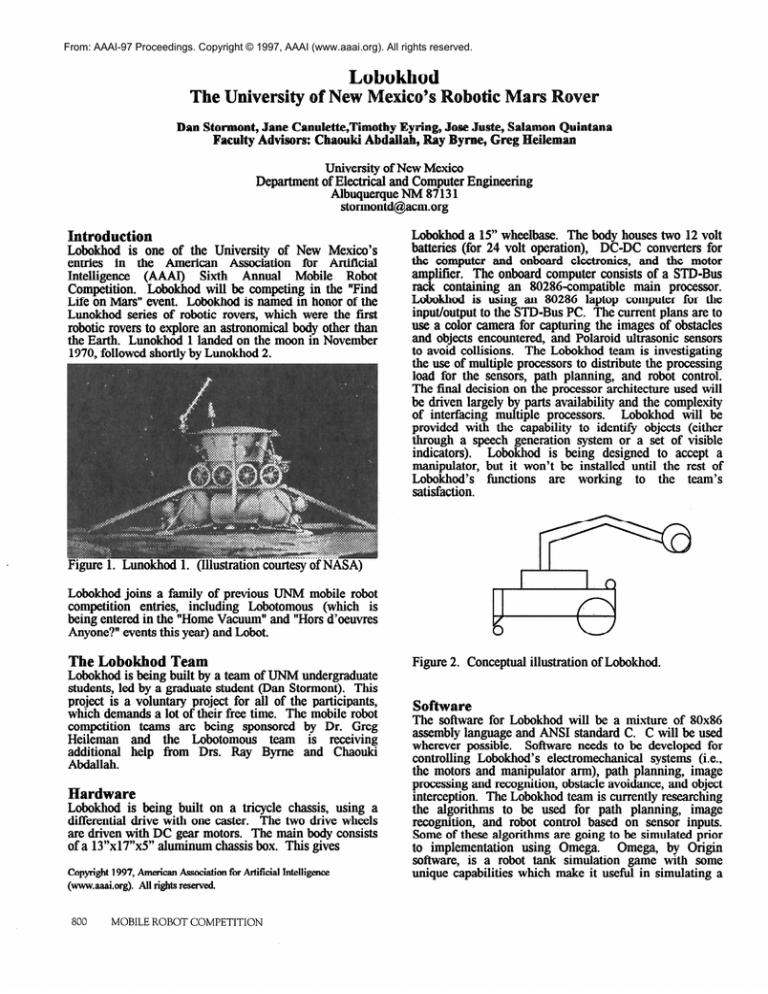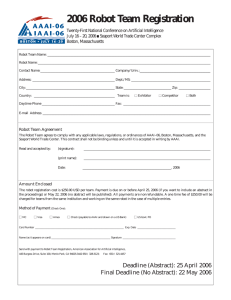
From: AAAI-97 Proceedings. Copyright © 1997, AAAI (www.aaai.org). All rights reserved.
Lobokhod
The University of IV
‘s
Dm Stormont,
Jane Canulette,Timothy Ey
Faculty Advisors: Chsasuki AMallah,
University of New Mexico
Department of Electrical and Computer Engineering
Albuquerque NM 87 131
stormontd@acm.org
Introduction
Lobokhod is one of the University of New Mexico’s
entries in the American Association for Artifkial
the Earth. Lunokhod 1 landed on the moon in November
1970, followed shortly by Lunokhod 2.
a 15” wheelbase. The body houses two 12 volt
batteries (for 24 volt operation), DC-DC converters for
i~~M~ou~ut to the STD-Bus PC. The current plans are to
use a color camera for capturing the images of obstacles
and objects encountered, and Polaroid ultrasonic sensors
to avoid collisions. The Lobokhod team is investigating
the use of multiple processors to distribute the processing
load for the sensors, path planning, and robot control.
The final decision on the processor architecture used will
be driven largely by parts availability and the complexity
of interfacing multiple processors.
Lobokhod will be
provided with the capability to identify objects (either
through a speech generation system or a set of visible
indicators).
Lobokhod is being designed to accept a
manipulator, but it won’t be installed until the rest of
Lobokhod’s functions are working to the team’s
satisfaction.
Lobokhod joins a family of previous UNM mobile robot
competition entries, including Lobotomous (which is
being entered in the “Home Vacuum” and “Hors d’oeuvres
Anyone?” events this year) and Lobot.
he Lobokhod Team
Lobokhod is being built by a team of UNM undergraduate
students, led by a graduate student (Dan Stormont). This
project is a voluntary project for all of the participants,
which demands a lot of their free time. The mobile robot
competition teams are being sponsored by Dr. Greg
Heileman and the Lobotomous team is receiving
additional help from Drs. Ray Byrne and Chaouki
Abdallah.
ardware
Lobokhod is being built on a tricycle chassis, using a
differential drive with one caster. The two drive wheels
are driven with DC gear motors. The main body consists
of a 13”xl7”x5” aluminum chassis box. This gives
Copyright 1997,American AssociationforAntiiicial intelligence
(www.aaai.org). All rights reserved.
800
MOBILE ROBOT COMPETITION
k-e
Figure 2. Conceptual illustration of Lobokhod.
Software
The software for Lobokhod will be a mixture of 80x86
assembly language and ANSI standard C. C will be used
wherever
Software needs to be developed for
controllin
od’s electromechanical systems (i.e.,
the motors and manipulator arm), path planning, image
processing and recognition, obstacle avoidance, and object
e Lobokhod team is currently researching
to be used for path planning, image
d robot control based on sensor inputs.
Some of these algori
are going to be simulated prior
to implementation using omega.
Omega, by Qrigin
software, is a robot tank simulation game with some
unique capabilities which make it useful in simulating a
mobile robot. The game has full editing capabilities for
the battleground (the “play area” for the robot) and the
Artificial Intelligence programming (the algorithm used),
as well as some limited editing capabilities for the tank
chassis. Using these editing capabilities, a mobile robot
can be simulated to a reasonable level of fidelity in an
environment similar to the contest conditious. This allows
various algorithms to be tested for suitability prior to being
implemented on Lobokhod.
Conclusiorr
The Lob&hod team faces a daunting challenge in getting
Lobokhod ready for the AAAI ‘97 mobile robot
competition. We expect to be able to field a competitive
robot by July, but even if we don’t, the learning experience
will be invaluable to every member of the Lobokhod team.
MOBILE ROBOT COMPETITION
801




